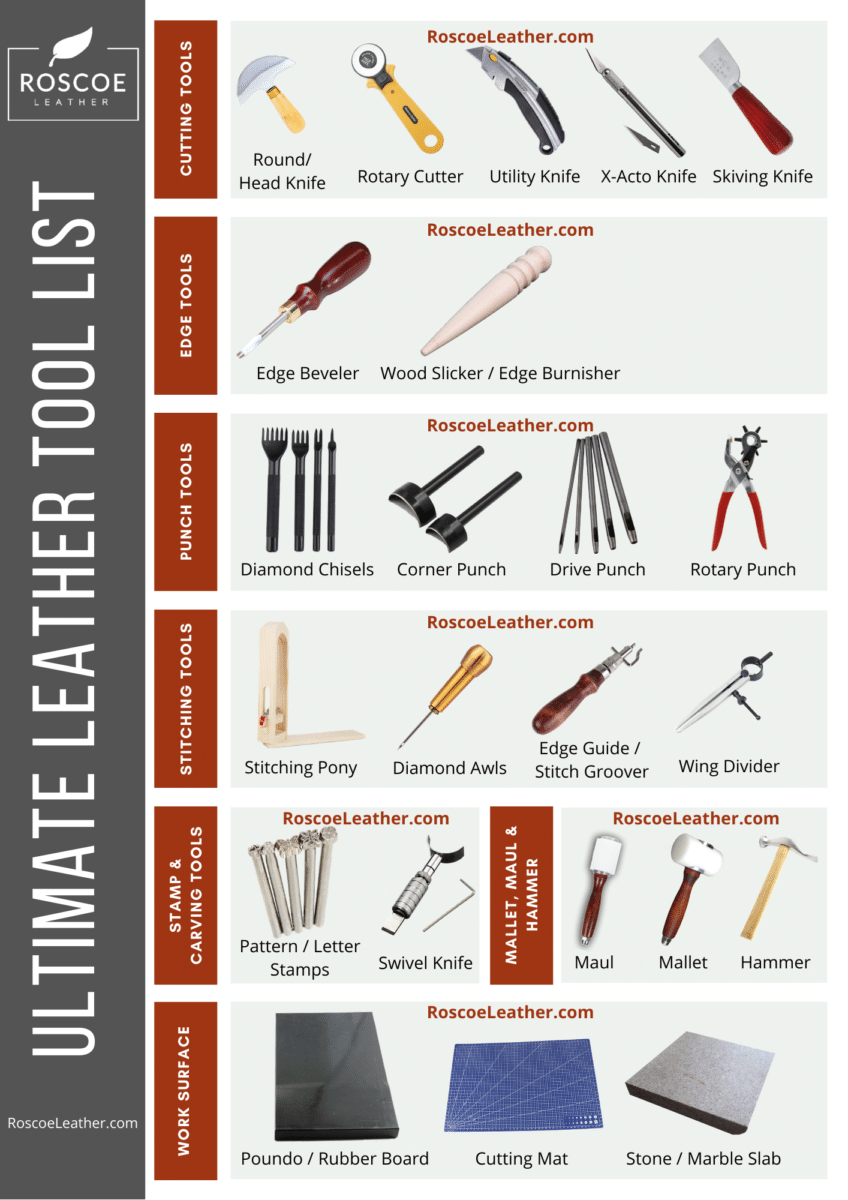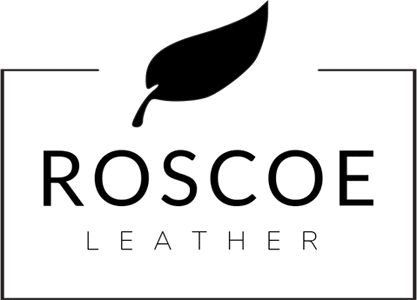To simplify the essential tools in Leathercraft / Leatherwork, I created a one-pager infographic and table so you can have an overall view and comparison. Enjoy!

Jump Ahead - Click the tool you wish to checkout
1. Cutting Tools
– Round / Head Knife
– Rotary Cutter
– Utility Knife / Box Cutter
– X-Acto / Precision Knife
– Skiving Knife
2. Edge Tools
– Edge Beveler
– Edge Burnisher / Wood Slicker
3. Punch Tools
– Diamond Chisel
– Corner Punch
– Drive Punch
– Rotary Punch
4. Stitching Tools
– Stitching Pony
– Diamond Awl
– Edge Guide / Stitch Groover
– Wing Divider
– Pricking Iron
– Stitch Wheeler
– Thread
– Needle
5. Stamp & Carving Tools
– Pattern / Letter Stamp
– Swivel Knife
6. Maul, Mallet & Hammer
– Maul
– Mallet
– Hammer
7. Work Surface
– Poundo / Rubber Board
– Cutting Mat / Board
– Stone Slab
8. Others
– Foam brush / Sponge
– Sand paper
– Thread Zapper / Lighter
– Ruler
– Bone Folder
| Category | Name | Function |
|---|---|---|
| Cutter Tools | Round / Head Knife | The round knife also known as a head knife is versatile and can be used for all cutting purposes in leathercraft / leatherwork. Typically used for cutting thick leather and for skiving leather. You will need to do maintenance and sharpen the blade. I don’t find this beginner-friendly compared to the utility and x-acto knives which have cheap replaceable blades. Note: This requires you to learn how to sharpen a knife. |
| Rotary Cutter | The rotary cutter have circular blades that will spin along when you push/pull to cut leather. Suitable for thin leather and long straight cuts. I use this a lot. | |
| Utility Knife / Box Cutter | The utility knife is the perfect all-rounder beginner knife. It can be used on thick leather as well. I believe this is a great cutter to kickstart your leathercraft journey. You probably already have this sitting somewhere at home. Get the ones with the replaceable blades. Swap out the dull blades as you go. There are so many types, pick the one that feels the best for you. | |
| X-Acto / Precision Knife (RoscoeLeather.com) | X-Acto / Xacto / Precision Knife is a great all-rounder knife. The metal blades are sharp and replaceable. Personally, I use this for cutting finer detail. | |
| Skiving Knife | Skiving knife as the name suggest is used for skiving leather. Skiving to shave off thin layers of leather material. Personally, I use this alot for cutting as well for corner cuts and general cutting. (RoscoeLeather.com) | |
| Edge Tools | Edge Beveler (RoscoeLeather.com) | Edgers or Edge Bevelers are used to shave off the angled or square edges off the leather. The output will be a rounded edge. There are multiple sizes and the size depends on the leather thickness or your desired finishing. As a beginner, you can get a quick change edge bevelers that you can use with interchangeable tips / blades of different sizes. Don’t have to sharpen, can just buy new tips when needed. |
| Edge Burnisher / Wood Slicker | Edge burnisher or a slicker is used to burnish (smoothen) the edges of the leather. This is used to get a sleek and smooth finish to the leather edges. Typically used with a burnishing agent (Tokonole, Beeswax, Gum trag, water, etc..). Wooden slickers are multi-sized which are suitable for smaller projects. If you are doing projects with few leather pieces stitched together, you may need a bigger sized slicker. (RoscoeLeather.com) | |
| Punch Tools | Diamond Chisel | Diamond Chisels are use to produce straight, consistent diamond-sized holes for stitching. The chisels are used to to punch stitch holes along the stitch line. Available in 1,2,4,8 “teeth” variant. I mainly use this for all my projects. For curves, smaller teeth size will be used. |
| Corner Punch (RoscoeLeather.com) | Corner punches are metal tools with sharp, rounded edges used to cut through leather. The same round corners can be achieved with a knife. I used to cut round corners with a skiving knife. With some extra budget, this tool saves a lot of time. You get standardized corner cuts from this. Place it on the edge, and hit it with your mallet. Voila! | |
| Drive Punch | Drive punch is a one piece tool which automatically clean punched leather out the side of the barrel so there’s never any clogging. IMHO this is a gem compared to rotary punches which always leaves some kind of leather clogging (probably due to the quality of the rotary punch or my skill). Available in different sizes. (RoscoeLeather.com) | |
| Rotary Punch | This is a handheld multi-sized puncher. You can change size by turning the “wheel”. IMHO a quality rotary punch is a great and convenient tool but a cheap rotary punch is a nightmare. I had a couple cheap rotary punches which ended up breaking and not really doing the job. I use drive punches now. | |
| Stitching Tools | Stitching Pony | Stitching pony is a wooden tool with two arms which holds the leather item firmly in place so you can use both hands for lacing or sewing. Using both handstremendously makes the stitching process easier. |
| Diamond Awl (RoscoeLeather.com) | Diamond awl is a sharp metal point used for marking or piercing leather. It can be used to mark leather before cutting or making holes in leather for stitching. Typically, leather is marked with a pricking iron or stitch wheeler, then awl is used to pierce the marking to create a stitch hole. I seldom use this for my projects as diamond chisels are much faster. However, some leathercrafters prefer using an awl to have more control over the hole size. | |
| Edge Guide / Stitch Groover | Edge guide or stitch groover is a tool use to create markings or groove for stitching. It is used to create stitch lines near the edge of the leather. Stitch groover cuts out the leather to create a groove, this allows the stitching to sit in the groove. By applying lesser pressure, you can achieve similar markings as done by a wing divider. (without groove) (RoscoeLeather.com) | |
| Wing Divider | The wing divider is a tool with 2 pointy arms used to create markings on leather. Wing divider is used to mark stitch lines along the edges. You can adjust the distance between the arms and secure them in position. The arms are pointy which are useful for precision work. | |
| Pricking Iron | Pricking iron looks like a chisel, but it is only meant for marking the holes. Used together with diamond / stitching awls. Place along stitch line, hammer it lightly to mark the leather. Pierce the markings with an awl to make the hols. Personally, I use Diamond chisels now. | |
| Stitch Wheeler | Stitch wheeler is used for marking stitch hole locations on leather. It has a metal wheel with sharp points on it. Used together with an awl. Awls will be used to pierce the markings to create the stitch holes. Personally, I use Diamond chisels now. | |
| Thread | You would need waxed threads as it will be easier to handle (prevents tangling) and works well with leather. Threads are available in many different materials, colours and sizes. Choosing the type of thread material or size is based on personal preference. Common materials are nylon, linen and polyester. Thread sizes are typically available in 0.6mm, 0.8mm, 1.0mm and 1.2mm etc. Different brands have different sizing model. Which thread size to choose depends on what looks good to you and also the size of the product. I personally prefer 0.8mm as it looks good on all projects. | |
| Needle | “Everyone uses John James needles”. This is probably true. They are known for being strong and a pack will last a long time. Needles are available in multiple sizes depending on the thread and stitch hole size, which then depends on your project. Thread and needle size often relates to stitch per inch (SPI). Will create another post to explain more on this. Typically 6-8 SPI works for most projects. In short, getting a John James size #2 for <10SPI and #4 >10SPI. | |
| Stamp & Carving Tools | Pattern & Letter Stamps | Pattern and Letter stamps are metals tools used to imprint patterns or letters into leather. You place the end with the pattern on the leather surface, use a mallet or maul to strike the stamp to imprint the pattern onto the leather. (RoscoeLeather.com) |
| Swivel Knife (RoscoeLeather.com) | Swivel knife is a tool that is used for carving patterns on leather. You place your index finger the curved area at the top for dexterity when carving intricate designs. Personally, I don’t see this as a beginner tool unless you are into carving patterns. | |
| Maul, Mallet & Hammer | Maul | Maul is a striking tool with a round / cylinder shape wrapped with poly around the head. Comes in various sizes and weight. You can grip the maul differently depending on the task. Gripping part of the head may offer some extra dexterity for more precision strikes. The arm / hand movement from using the maul differs from a mallet / hammer, you tend to use more wrist movements as opposed to arm swinging movements. The smaller impact surface ensures a better strike compared to mallets. (RoscoeLeather.com) |
| Mallet (RoscoeLeather.com) | Mallet is another striking tool that is widely used in leathercraft. It basically has a hammer style shape. Materials used are wood, rawhide, plastic and rubber. I personally dont recommend using the wooden mallet, unless you have limited budget. Rawhide or plastic is durable and will work great. Perfect to strike your punch and stamp tools. | |
| Hammer | Hammers are similar to the hammers you use for hitting nails. Since it has a metal surface, metal hammers are not suitable for striking punch tools or other metal tools. You may potentially damage the tools when striking metal with metal. I typically use these to hammer down my stitchings, works great to tap down seams. I use a maul for other striking tasks. | |
| Work Surface | Poundo / Rubber Board | Poundo / Rubber board is a piece of rubber board which is suitable for punching and cutting leather. It protects your knife and work desk. Rubber surface helps protect knife edges and hole punches from dulling and chipping. Typically placed below your slabs as a damping surface to mute the sound and reduce impact directly to your work desk. When cutting leather, it allows the blade to slightly “cut” into the board to protect the knife and to provide a clean straight cut. |
| Cutting Mat (RoscoeLeather.com) | Cutting mat as the name suggest is used for cutting leather. It protects your knife and work desk. Self-healing mats have a flat and smooth surface which are perfect for leathercraft and will last for a long time. When cutting leather, it allows the blade to slightly “cut” into the board to protect the knife and to provide a clean straight cut. Usually, there are measurement lines printed on the board which is can be used as a reference for cutting leather pieces. Another option is a poly board which is like your kitchen cutting board. It is harder than poundo boards but soft enough to protect your tools during cutting and punching. | |
| Stone Slab | Stone slabs is a block of stone used for shock absorption underneath leather punching, stamping, and cutting tools. Quartz, granite, and marble are typical material used for these slabs. Stone slabs are nice and smooth which is great for leathercraft / leatherwork as it won’t damage the leather when moving the leather around the work surface. Slabs use to absorb shock when mauling, thus placed on a rubber mat below the slab to dampen the sound when tooling. (RoscoeLeather.com) |
Few other tools worth mentioning:
- Foam brush / Sponge : Used to apply glue/dye/conditioner/finishing
- Sand paper : Used to sand leather edges before beveling
- Thread Zapper / Lighter : Used to burn end of thread
- Ruler : Self explanatory
- Bone Folder : Used for creasing. It can be used to open up pockets after glue and stitching.
All in one Leather Working Tools – Best Deal!
Other supplies and materials will be explained in further chapters. In chapter 4, we will explain the types of leather and which leather you should choose for your project.
Leathercraft Basics – Table of Content
Chapter 1: Leathercraft Basics Introduction
Chapter 2: Understanding the Leathercraft Process
Chapter 3: Tools Needed for Leathercraft (You are here)
Chapter 4: Leather Explained – Choosing The Right Leather
Chapter 5: Leather Dye
Chapter 6: Burnishing Agents
Chapter 7: Adhesive / Glue
Chapter 8: Leather Finishes
Chapter 9: Leathercraft Techniques (Coming Soon)
Chapter 10: Machinery used in Leathercraft (Coming Soon)



